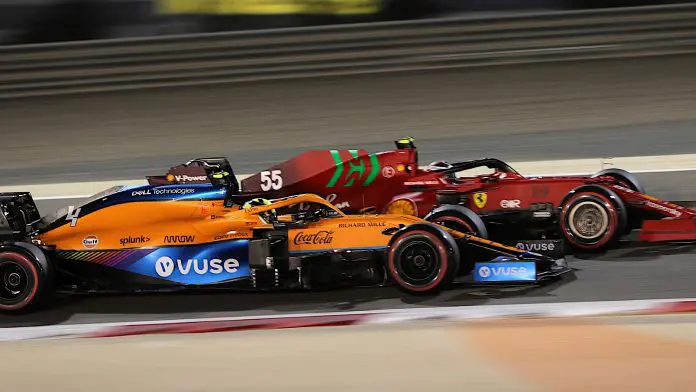Ferrari vs McLaren, tied at 163 points in the Constructors’ championship. Two teams that went down in history as the most dominant ones in the sport are battling it out for 3rd place in the 2021 championship, behind the unreachable Mercedes and Red Bull. The SF21 and the MCL35M are polar opposites in their strengths and, in fact, the two F1 performed at their best on different tracks. It is about very specific characteristics that make the close fight that, presumably, will last until the end of the world championship, exciting.
In a season where updates do not play a key role, due to the strong commitment on the 2022 projects, understanding the current car and its set-up turned out to be very effective to extrapolate the maximum performance from the car. Who will be able to carry out an account with more wit, in each of the remaining rounds, will be able to enjoy a considerable advantage.
At this point, there is a question that needs to be asked. When the early feedback from the track highlighted strengths and weaknesses of these cars, what was the technical path taken by the teams to improve the cars? To find out, let’s briefly review the last months that led us to the summer break.
F1, Analysis – SF21 vs MCL35M: find downforce points at the rear
During pre-season testing, the British engineers designed a single-seater endowed with several interesting solutions. One above all is the interesting configuration of the extractor, with the “fusion” of the innermost bulkheads with the body of the diffuser to lengthen these appendages up to the limit given by the reference plan (click here for technical details).
Expectations for the papaya single-seater were very high and there were those who would even bet on the Woking team battling it out with his majesty’s fourteen Mercedes AMG F1 in the Constructors’. Until last season there was a clear condition within the English team, which we could summarize in this way, if it were a statement: “Our car is very solid in terms of chassis and aerodynamics. The only thing missing to make the definitive leap in quality is horsepower”.
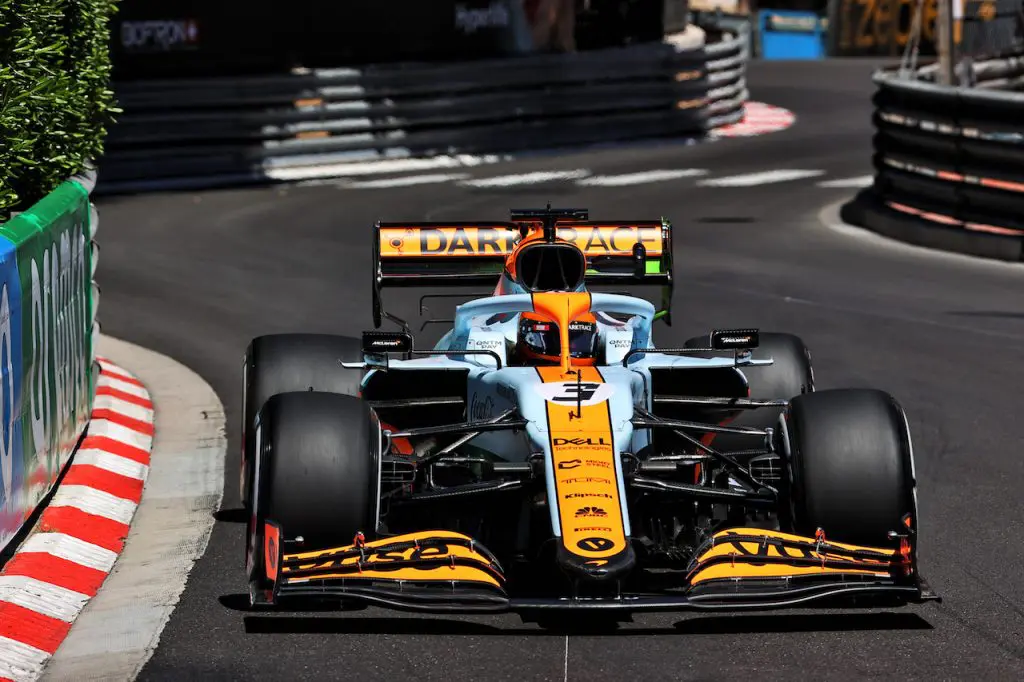
This vision turned out to be perhaps a little too simplistic. The switch to the German engine, in fact, forced the team to overhaul much of the car’s central and rear aerodynamics. And this is where the main problem comes from: the lack of downforce on the rear. Such deficiency did not allow the MCL35M to adapt to the most tortuous tracks.
To try and reduce this disadvantage, the British engineers have concentrated the aerodynamic development to make the car’s floor work at its best. In March, during pre-season testing, very few laps were enough to realize where the problem was rooted. That’s why, already in Portugal, the third round of the championship, the first corrections arrived. Basically, work of micro aerodynamics was done on the front to direct the flow in a different way.
While at Le Castellet, weekend of the French Grand Prix, the side bulkhead of the rear wing was modified and again in Styria, in the second weekend of the Austrian back-to-back, the English technicians mounted a new floor, decidedly richer in flow deviators.
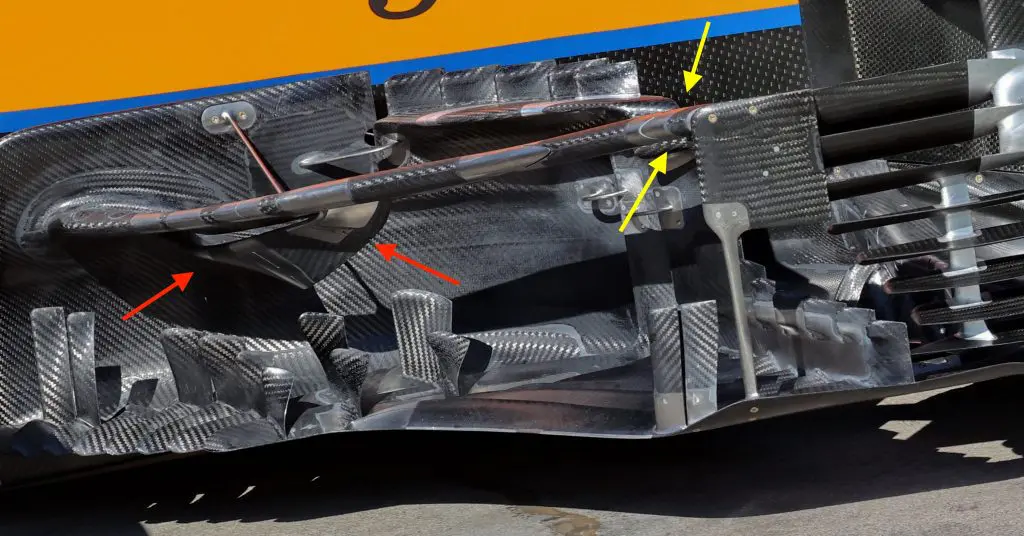
Finally, in Hungary, the development was completed with a substantial change to the bargeboards (click here for the technical details of this solution). The goal was to produce greater thrust in the rear. To do this, we tried to increase the outwash effect generated by the car. This operation also helped to remove the turbulent flows arriving from the front wheels, otherwise “sucked” by the depression below the bottom and consequently harmful to the aerodynamic performance.
F1, Analysis – SF21 vs MCL35M: adapting to the tracks and downforce
The technicians of Maranello had the duty to cancel the terrible 2020 season with a clean slate. In order to do this, there were several areas to intervene in. Although the work done by the engineers of the Reparto Corse has given birth to a more competitive power unit when compared with the disappointing version mounted on the SF1000, the deficit on the Mercedes and Honda PUs remains tangible. With the resolution of the new specification that will be introduced on the SF21 in late September (read here to discover all the technical characteristics of the new Italian engine), the engineers of the “Cavallino Rampante” hope to be able to close part of the gap on the top tiers.
On the aerodynamic and mechanical level, on the other hand, we can define the progress made during the winter as very good. Although by regulation the SF21 necessarily had to share the chassis (certainly not an optimal factor) with last season’s single-seater, the work done by the men in red in various areas of the car was more than satisfactory. Compared to McLaren, the Italian team of technicians has heavily focused on optimizing the package, evaluating the pure development of the car as less effective in terms of costs and timing.

Being able to maximize the performance of the car race by race, with a massive work of analysis supported by the cross-comparison between the data collected on the track and those generated by the simulator, was immediately considered the best way for Binotto and company. Nevertheless, some updates have arrived. The first appeared two weeks after their debut, in Imola, with a slight modification to the front wing string and a new floor configuration further modified in Portugal.
A month later in France, the Italian team again intervened on the last flap of the front wing. The modification to the portion that adjusts the angle of attack, by increasing the amount of “adjustable” load produced, served to correct an annoying understeer that often occurred when switching from one compound to another. Furthermore, at Le Castellet, the lower part of the endplate has been resized (click here for details). This allowed for a higher top speed while maintaining the same downforce level.
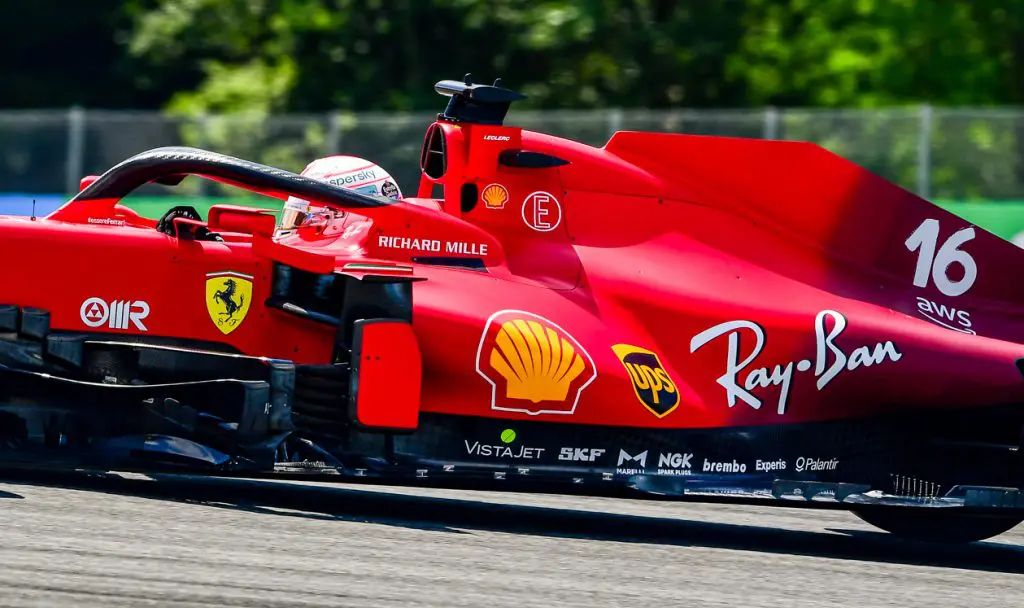
The last upgrade was dated 25 June, when Charles Leclerc took to the track during the Austrian FP1 with a different version of the floor. This specification, then mounted at the next Grand Prix in Great Britain (click here to find out more), provided for a new series of vortex generators to increase the downforce.
F1, Analysis – SF21 vs MCL35M: drawing a direct comparison
Delving into the specifics, let’s now examine some interesting data thanks to our exclusive telemetry. The graph below perfectly represents the differences and characteristics of the cars under discussion. Austrian GP 2021. Qualifying. Q3. Leclerc vs Norris. The speed track gives us the opportunity to draw clear conclusions.
The British single-seater, exploiting the aerodynamic efficiency and power of the Mercedes engine, is able to build an excellent advantage in the portion of the track that unwinds from turn one to the braking of turn four.
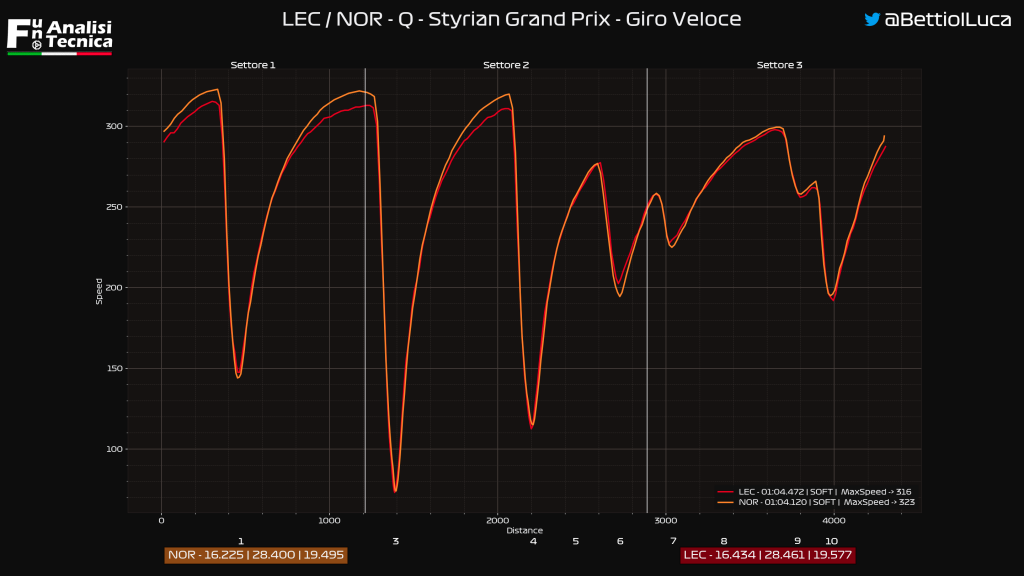
On the other hand, the SF21 performs well in the traction areas, as well as in the high-speed support and wide radius areas such as turns six and seven. Bearing in mind the different peculiarities of the cars, one factor that can decide the outcome of this intriguing challenge above all is the tyres. In fact, activating the compounds in all circumstances will be the key to being able to perform at the top in the second half of the season.
In the initial phase of this championship, Ferrari showed its impressive skills in the management of the Pirelli compounds in qualifying. Although the trend is gradually improving, the same unfortunately cannot be said about the race. Here, on the contrary, McLaren immediately showed a lower average degradation during the course of the race. Just think of Imola, when Norris easily caught up on Leclerc and overtook him in the last stint of the race.
It shall also be remembered, however, that McLaren, for various reasons, often struggled to bring the compounds into the right window of use during the classification sessions. From here, in fact, derive several average results. “Triggering” compounds quickly and keeping yourself at the right temperature is no small feat. This is why, on several occasions, we have defined this aspect of Ferrari on Saturday as positive.
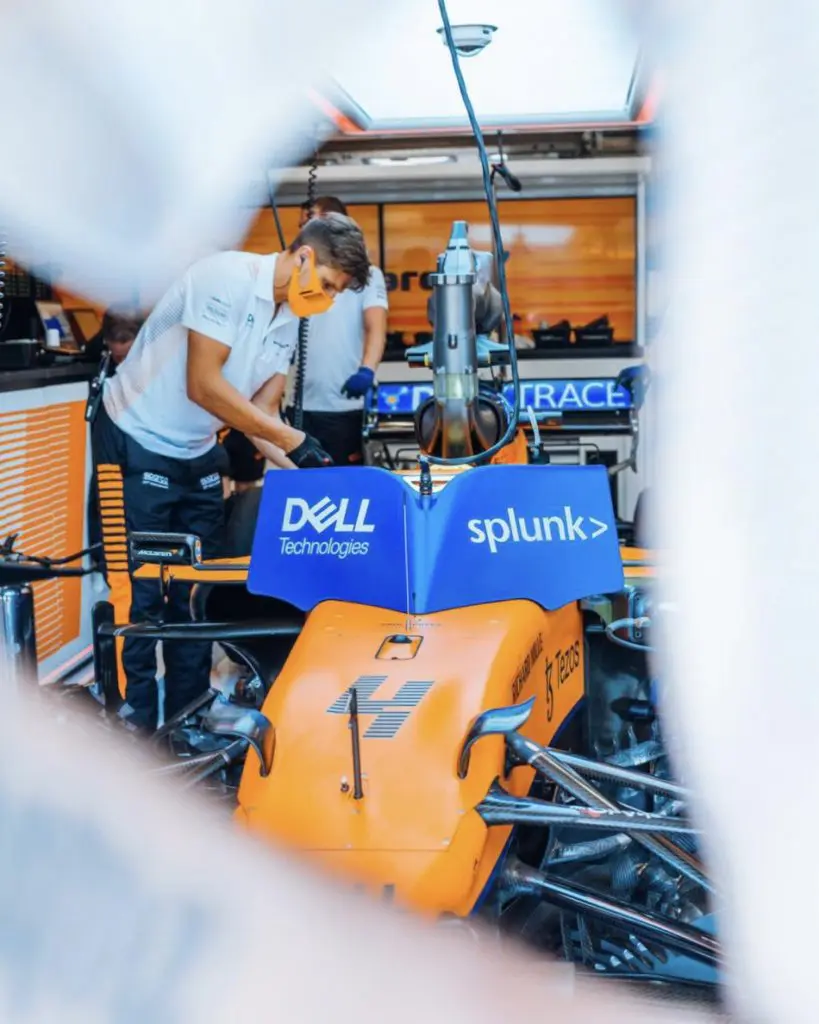
Continuing the discussion, although at first glance it might seem a secondary factor, there is another disadvantage that McLaren highlighted in the first part of the championship. It is an element capable of negatively affecting the performance of the car. Let’s talk about the inherent difficulty in identifying a good starting set-up during the first free practices.
This fact often forced the Woking engineers to do extra work on the simulator on the night between Friday and Saturday, resulting in last-minute changes in the last session before qualifying. It is the same problem that Ferrari experienced last season, which undoubtedly slows down the process of understanding the tyres considerably.
F1, Analysis – SF21 vs MCL35M: conclusions
The battle, as we can imagine, is articulated on several levels. As we mentioned, Ferrari can count on truly remarkable traction, a peculiarity that allowed to claim pole positions like at Monaco. Furthermore, it proved to be a decidedly more flexible car than expected, an element that allowed comforting performance in non-optimal tracks on paper. However, the set-up window of the car is not that big. For this reason, finding the ideal compromise between qualifying and the race has not always proved to be an easy task.
But the real weakness of the Red Car, which so far has balanced the battle with McLaren, is the management of power in the race. The German power unit enjoys optimal efficiency that allows it to release a higher amount of energy over the course of the session. This, added to the horsepower gap that the Italian endothermic still pays, has pushed the scales too often towards the Woking stable. Delivering less power has denied overtaking on the MCL35M on several occasions, despite the fact that the SF21s demonstrated a much higher pace.
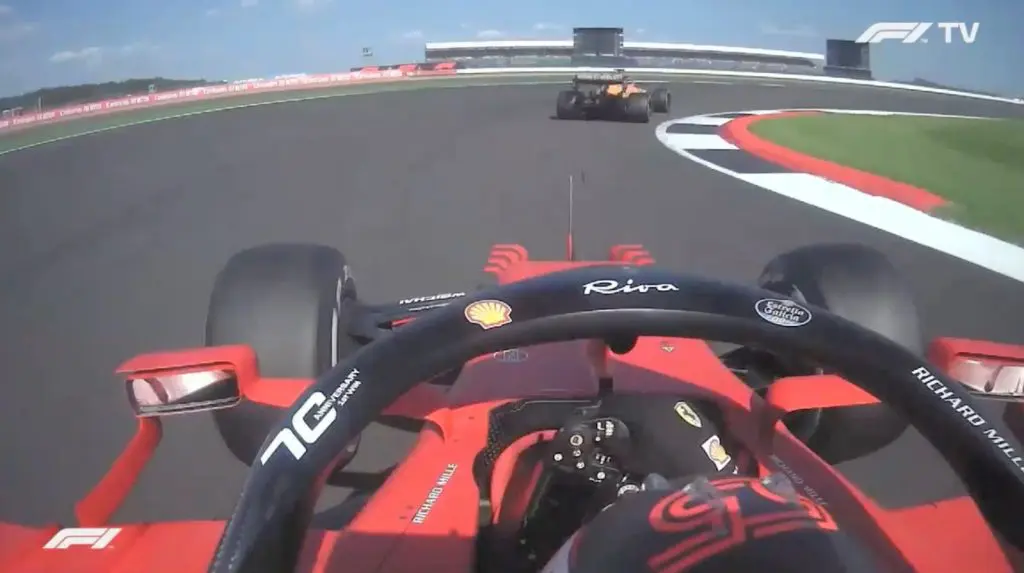
Both teams have several areas for improvement available. Assuming that we are unlikely to see significant aerodynamic updates from now on, Ferrari could have a decent advantage over the introduction of the new Power Unit. For the rest, the weekend maximization will make a difference.
Who between the two teams will be able to enhance their qualities more and at the same time “hide” the defects will gain an effective advantage to win the third place in the 2021 world championship.
Authors: Alessandro Arcari – @berrageiz e Niccoló Arnerich – @niccoloarnerich
Translation for: Beatrice Zamuner – @ZamunerB

